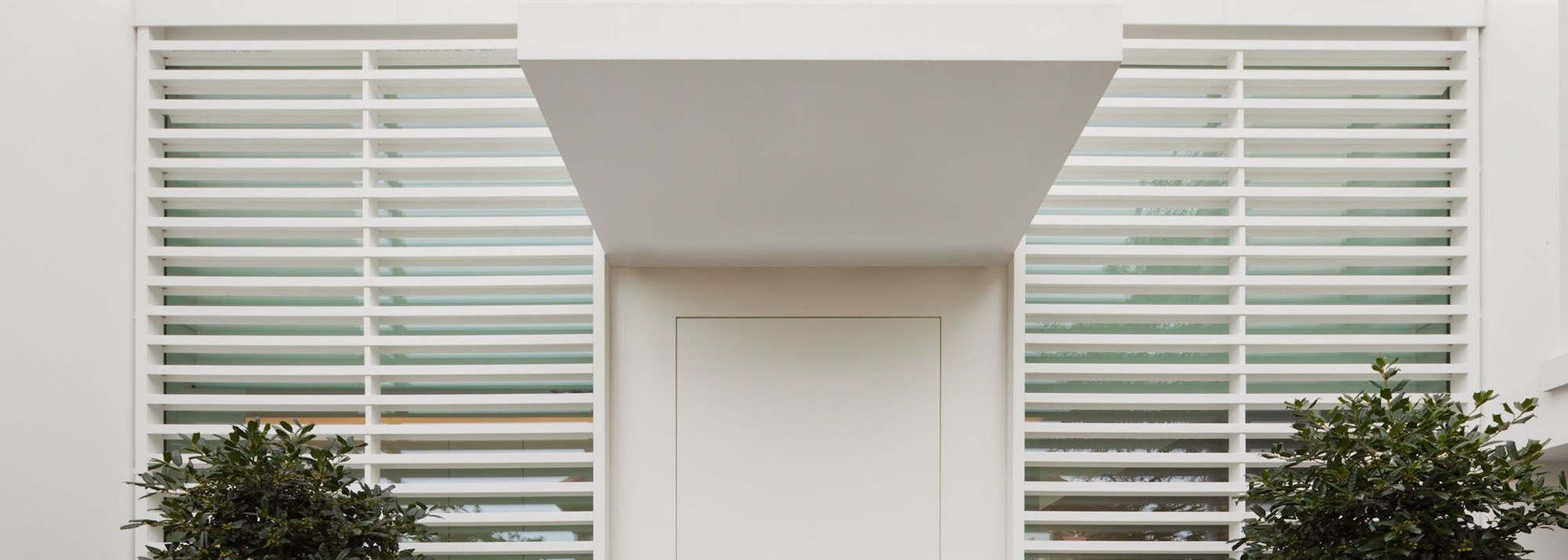|
|
| |
Abdülaziz 1830-1876 1861-1876 |
“Reception for the Sultan of Turkey, Guildhall, City of London, 1867
”
🔎
.jpg)
|
Reception for the Sultan of Turkey, Guildhall, City of London, 1867
(Empfang für den Sultan der Türkei, Guildhall, City of London, 1867)
1867 | lithograph
|
|
| |
|
Abdülaziz
Abdülaziz Abdülaziz 1830-1876 1861-1876 (W)
Family
Family
- First marriage
- Dürrünev Kadın (Batumi, c. 1835 – Feriye Palace, Istanbul, 7 December 1895, buried in Mahmud II Mausoleum), married at Istanbul, Dolmabahçe Palace in 1856, and had issue:
- Şehzade Yusuf Izzeddin (11 October 1857 – 1 February 1916);
- Şehzade Mehmed Bahaeddin (February 1883 – 8 November 1883);
- Hatice Şükriye Sultan (24 February 1906 – 1 April 1972);
- Şehzade Mehmed Nizameddin (10 January 1909 – 19 March 1933);
- Mihriban Mihrişah Sultan (1 June 1916 – 25 January 1987);
- Fatma Saliha Sultan (Istanbul, Dolmabahçe Palace, 11 July 1862 – 1941, Cairo, Egypt, and buried in Khedive Tewfik Mausoleum);
Second marriage
- Hayranidil Kadın (Kars, 21 November 1846 – Feriye Palace, Istanbul, 26 November 1895, buried in Mahmud II Mausoleum), married at Istanbul, Dolmabahçe Palace in 1861, and had issue:
Third marriage
- Edadil Kadın (c. 1845 – Dolmabahçe Palace, Istanbul, 12 December 1875, buried in Mahmud II Mausoleum), married at Istanbul, Dolmabahçe Palace in 1861, and had issue:
- Şehzade Mahmud Celaleddin (14 November 1862 – 1 September 1888);
- Şehzade Mehmed Selim (28 October 1865 – 21 October 1867);
- Emine Sultan (Istanbul, Dolmabahçe Palace, 30 November 1866 – 23 January 1867, Istanbul, Dolmabahçe Palace, buried in Sultan Mahmud II Mausoleum, Divanyolu, Istanbul);
Fourth marriage
- Nesrin Kadın (Sochi, c. 1848 – Feriye Palace, 11 June 1876, Istanbul, buried in New ladies Mausoleum), married at Istanbul, Dolmabahçe Palace in 1868, and had issue:
- Şehzade Mehmed Şevket (5 June 1872 – 22 October 1899);
- Şehzade Mehmed Cemaleddin (28 October 1890 – 18 November 1946);
- Emine Sultan (Istanbul, Dolmabahçe Palace, 24 August 1874 – 29 January 1920, buried in New Mosque, Istanbul);
Fifth marriage
- Gevheri Kadın (Gudauta, 8 July 1856 – Feriye Palace, Istanbul, 6 September 1884, buried in New ladies Mausoleum), married at Istanbul, Dolmabahçe Palace in 1872, and had issue:
- Şehzade Mehmed Seyfeddin (21 September 1874 – 19 October 1927);
- Şehzade Mehmed Abdülaziz (26 September 1901 – 19 January 1977);
- Şehzade Mahmud Şevket (30 July 1903 – 1 February 1973);
- Şehzade Ahmed Tevhid (30 November 1904 – 24 April 1966);
- Fatma Gevheri Sultan (30 November 1904 – 10 December 1980);
- Esma Sultan (Istanbul, Dolmabahçe Palace, 21 March 1873 – 7 May 1899, buried in Sultan Mahmud II Mausoleum, Divanyolu, Istanbul);
|

|
|
|
|
Abdülaziz (Ottoman Turkish: عبد العزيز / ʻAbdü'l-ʻAzīz, Turkish: Abdülaziz; 8 February 1830 – 4 June 1876) was the 32nd Sultan of the Ottoman Empire and reigned between 25 June 1861 and 30 May 1876. He was the son of Sultan Mahmud II and succeeded his brother Abdulmejid I in 1861.
Born at Eyüp Palace, Constantinople (present-day Istanbul), on 8 February 1830, Abdülaziz received an Ottoman education but was nevertheless an ardent admirer of the material progress that was made in the West. He was the first Ottoman Sultan who travelled to Western Europe, visiting a number of important European capitals including Paris, Londonand Vienna in the summer of 1867.
Apart from his passion for the Ottoman Navy, which had the world’s third largest fleet in 1875 (after the British and French navies), the Sultan took an interest in documenting the Ottoman Empire. He was also interested in literature and was a talented classical music composer. Some of his compositions, together with those of the other members of the Ottoman dynasty, have been collected in the album European Music at the Ottoman Court by the London Academy of Ottoman Court Music. He was deposed on grounds of mismanaging the Ottoman economy on 30 May 1876, and was found dead six days later under unnatural and mysterious circumstances. |
Early life
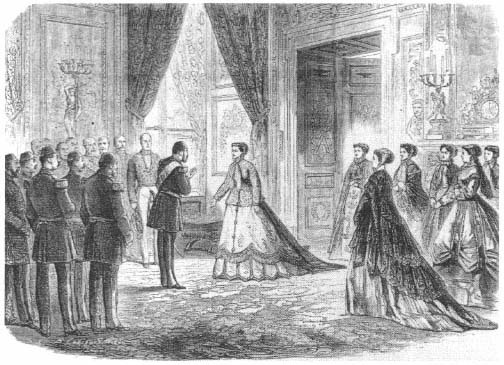
1867 Sultan Abdulaziz' visit to Napoleon III. |
|
|
| |
|
His parents were Mahmud II and Pertevniyal Sultan (1812-1883), originally named Besime, a Circassian. In 1868 Pertevniyal was residing at Dolmabahçe Palace. That year Abdülaziz took the visiting Eugénie de Montijo, Empress of France, to see his mother. Pertevniyal considered the presence of a foreign woman within her private quarters of the seraglio to be an insult. She reportedly slapped Eugénie across the face, which almost caused an international incident. According to another account, Pertevniyal was outraged by the forwardness of Eugénie in taking the arm of one of her sons while he gave a tour of the palace garden, and she gave the Empress a slap on the stomach as a possibly more subtly intended reminder that they were not in France.
The Pertevniyal Valide Sultan Mosque was built under the patronage of his mother. The construction work began in November 1869 and the mosque was finished in 1871.
His paternal grandparents were Sultan Abdul Hamid I and Sultana Nakşidil Sultan. Several accounts identify his paternal grandmother with Aimée du Buc de Rivéry, a cousin of Empress Joséphine. Pertevniyal was a sister of Khushiyar Qadin, third wife of Ibrahim Pasha of Egypt. Khushiyar and Ibrahim were the parents of Isma'il Pasha. |
| |

Voyage de S.-M. Imperatrice a Constantinople. |
|
|
| |
|
|
| |

Ottoman Exhibtion Building Constantinople, 1863 (Victorian engraving from The Illustrated London News April 11th, 1863). |
|
|
| |
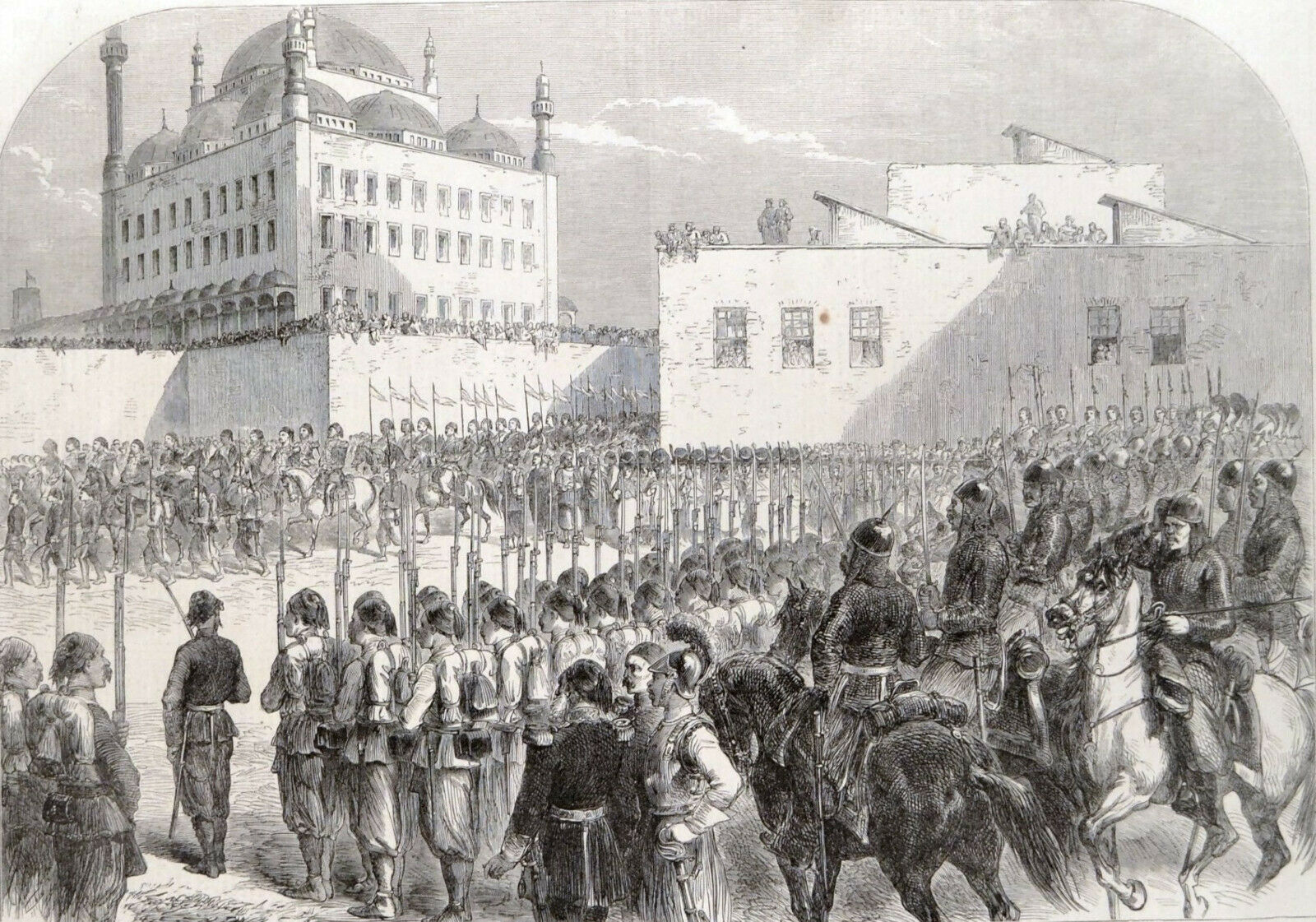
1863, THE RECEPTION AT CAIRO OF THE SULTAN’S ENVOY TO THE NEW PACHA OF EGYPT. From The Illustrated London News April 11th, 1863. |
|
|
| |
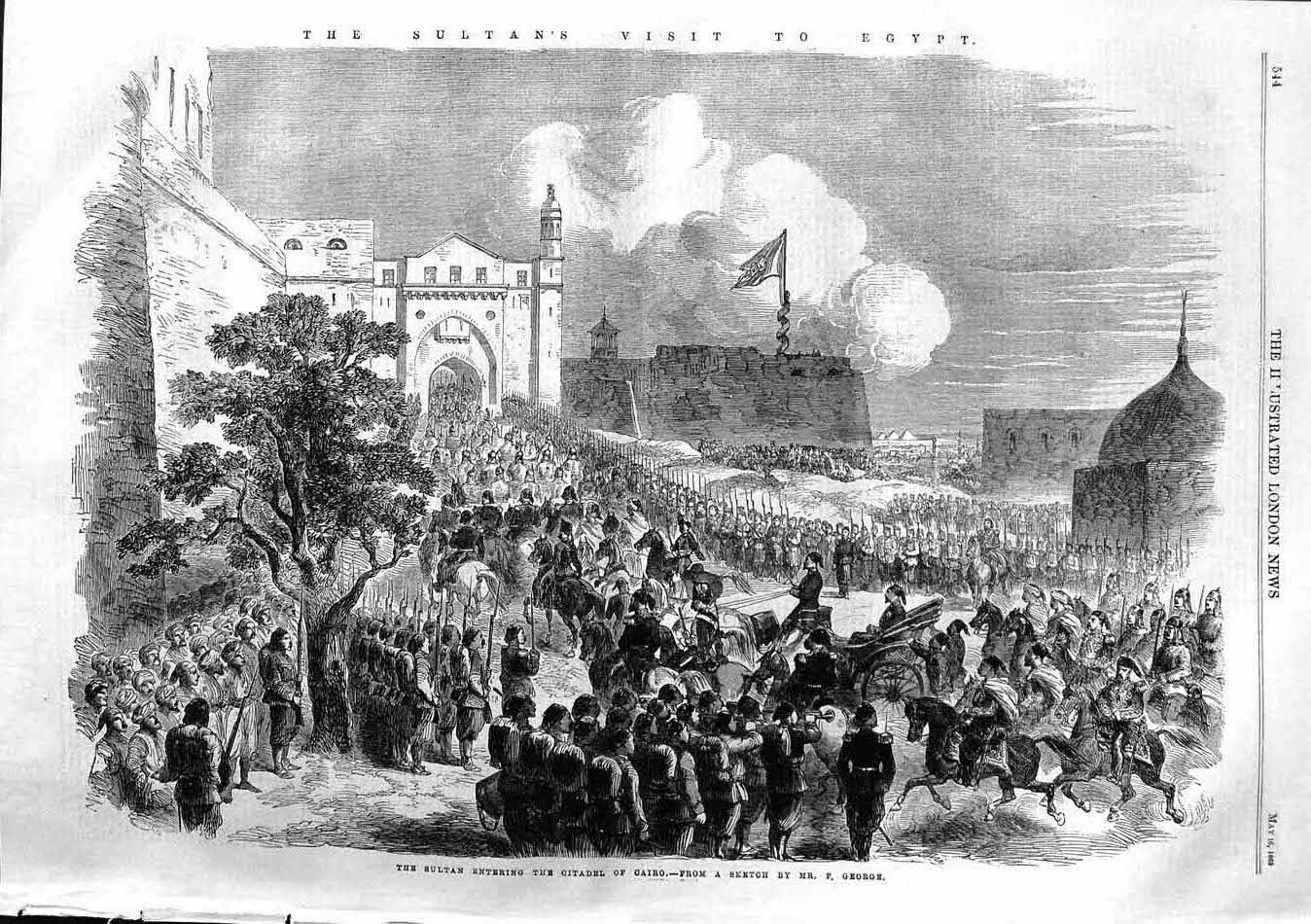
Original Old Antique Print 1863 Scene, Sultan Entering Citadel of Cairo, Egypt from the Illustrated London News dated 1863; sketch By F. George. |
|
|
| |
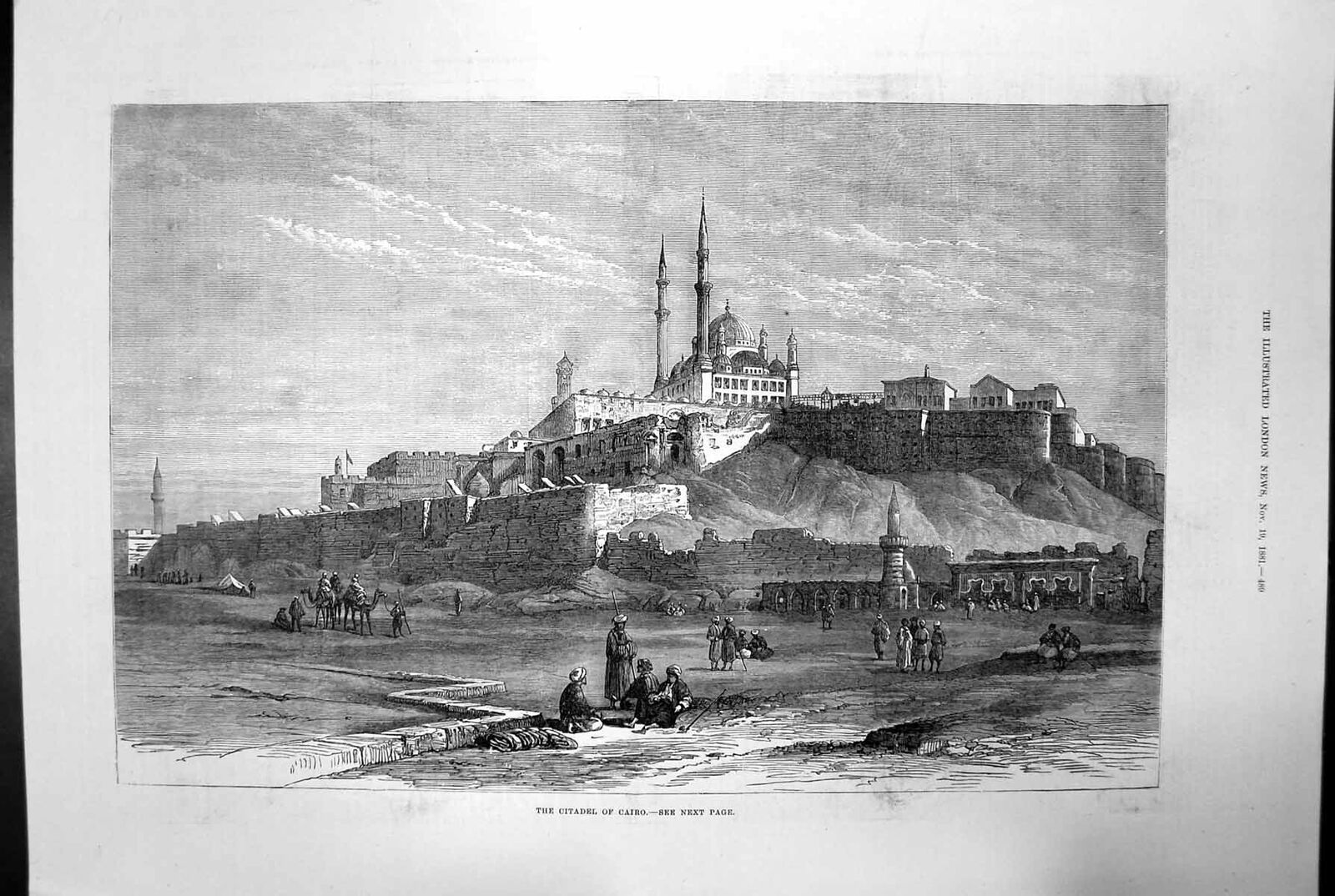
Original Old Antique Print The Citadel Cairo Egypt Rock Castle 1881 Victorian, from the Illustrated London News. |
|
|
| |

1863, Sultan Progress Through Cairo Egypt Procession Horses Carriage, from The Illustrated London News. |
|
|
| |
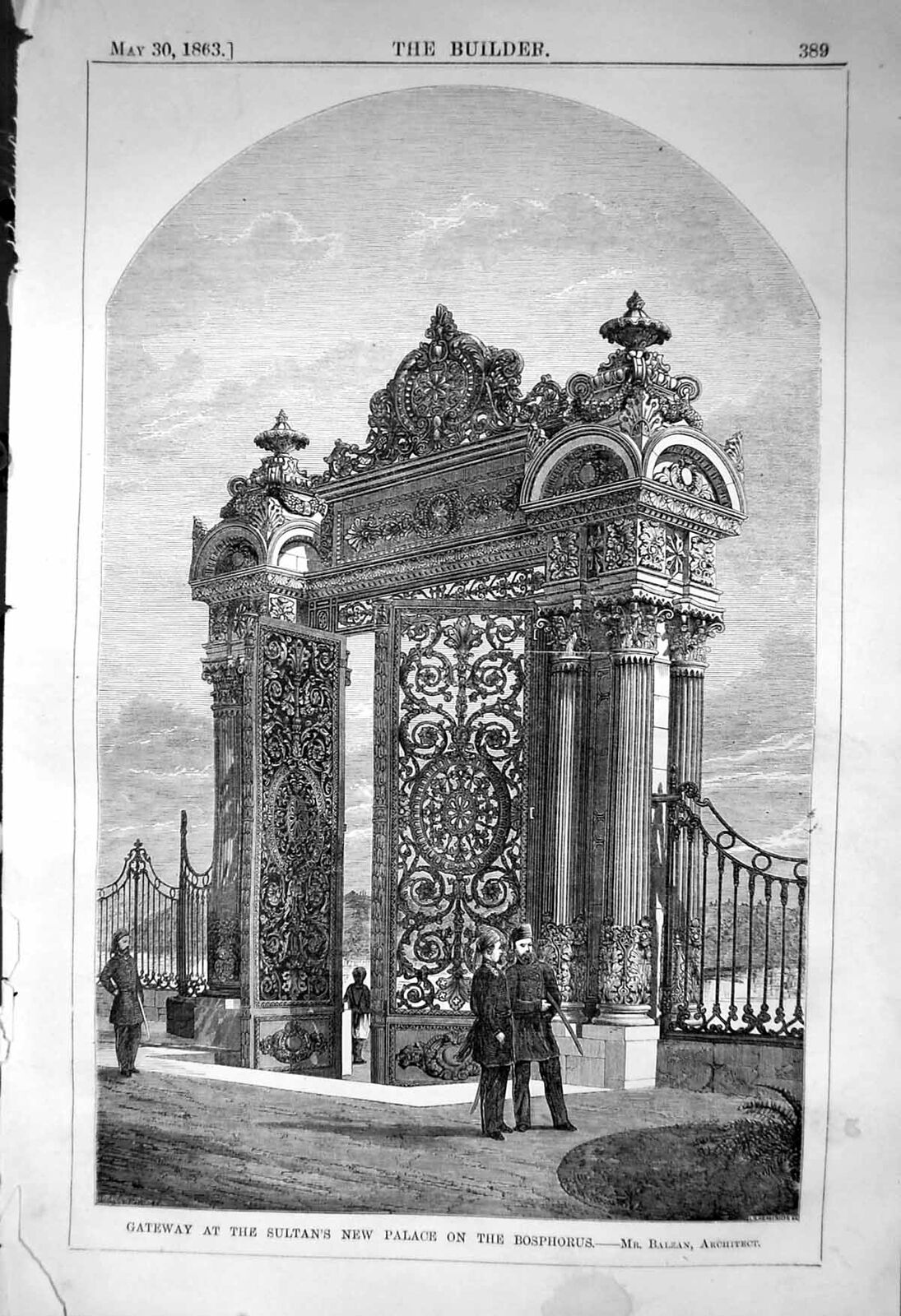
1863 Old Original Antique Victorian Print Gateway Sultan New Palace Bosphorus Balzan Architecture 1863 Builder. (The Builder is a magazine focusing on architecture, started in 1843 and has since continued publication till 2010). |
|
|
| |
.png)
1863 MAY 23 Original Antique Print taken from the Illustrated London News: “Sultan's Return from Egypt: Royal Yacht passing up the Bosphorus.” |
|
|
| |
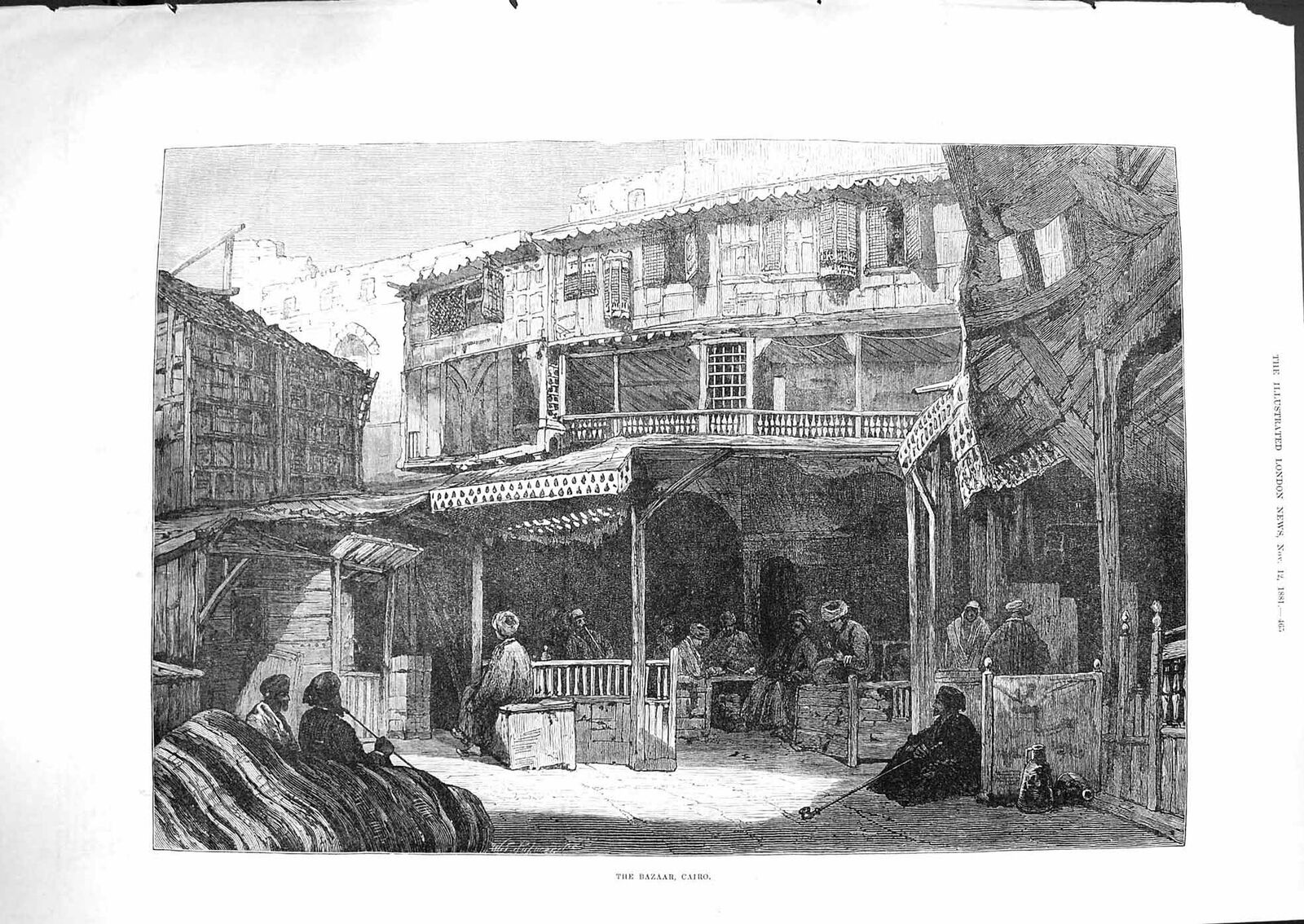
Original Old Antique Print 1881 Scene Bazaar Cairo Egypt Buildings Fine Art. |
|
|
Reign
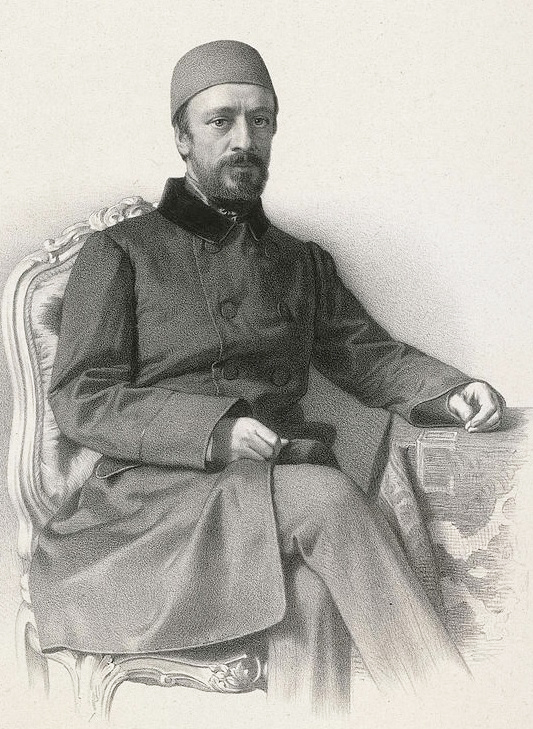
Mehmet Emin Ali Paşa. |
|
|
| |
|
Between 1861 and 1871, the Tanzimat reforms which began during the reign of his brother Abdulmejid I were continued under the leadership of his chief ministers, Mehmed Fuad Pasha and Mehmed Emin Âli Pasha. New administrative districts (vilayets) were set up in 1864 and a Council of State was established in 1868. Public education was organized on the French model and Istanbul University was reorganised as a modern institution in 1861. He was also integral in establishing the first Ottoman civil code. |
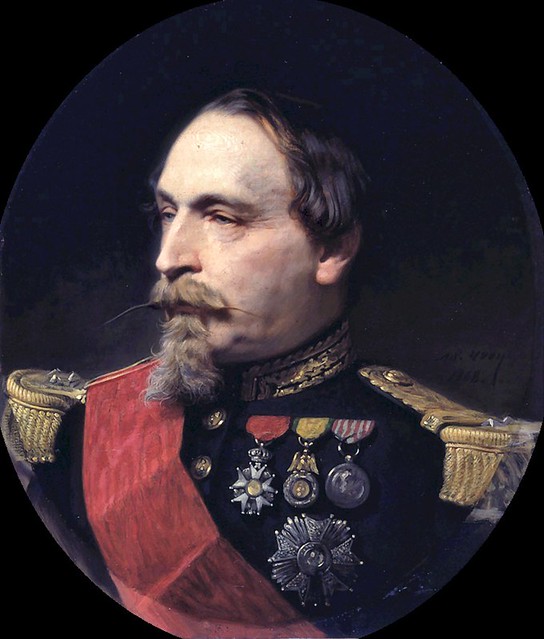
Napoleon III. |
|
|
| |
|
Abdülaziz cultivated good relations with the Second French Empire and the British Empire. In 1867 he was the first Ottoman sultan to visit Western Europe; his trip included a visit to the Exposition Universelle (1867) in Paris and a trip to the United Kingdom, where he was made a Knight of the Garter by Queen Victoria and shown a Royal Navy Fleet Review with Ismail Pasha. He travelled by a private rail car, which today can be found in the Rahmi M. Koç Museum in Istanbul. His fellow Knights of the Garter created in 1867 were Charles Gordon-Lennox, 6th Duke of Richmond, Charles Manners, 6th Duke of Rutland, Henry Somerset, 8th Duke of Beaufort, Prince Arthur, Duke of Connaught and Strathearn (a son of Queen Victoria), Franz Joseph I of Austria and Alexander II of Russia.
|
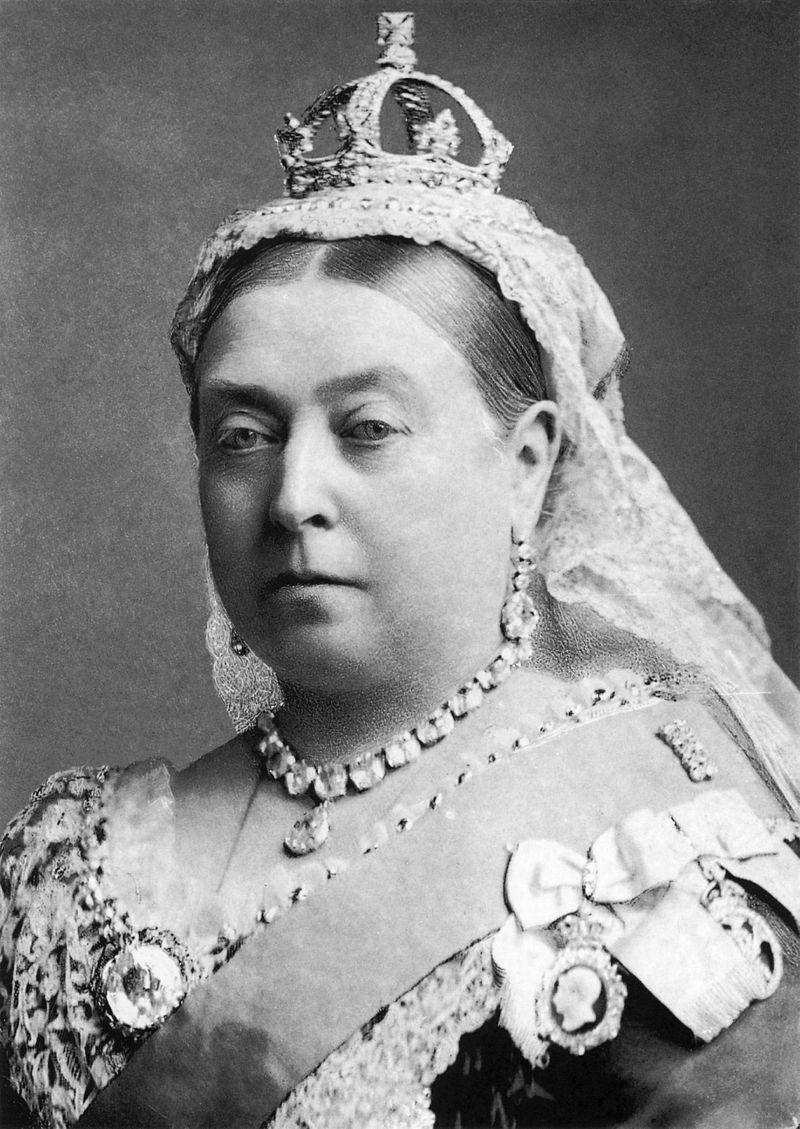
Photograph of Queen Victoria, 1882. |
|
|
| |
|
Also in 1867, Abdülaziz became the first Ottoman Sultan to formally recognize the title of Khedive (Viceroy) to be used by the Vali (Governor) of the Ottoman Eyalet of Egypt and Sudan (1517-1867), which thus became the autonomous Ottoman Khedivate of Egypt and Sudan (1867-1914). Muhammad Ali Pasha and his descendants had been the governors (Vali) of Ottoman Egypt and Sudan since 1805, but were willing to use the higher title of Khedive, which was unrecognized by the Ottoman government until 1867. In return, the first Khedive, Ismail Pasha, had agreed a year earlier (in 1866) to increase the annual tax revenues which Egypt and Sudan would provide for the Ottoman treasury. Between 1854 and 1894, the revenues from Egypt and Sudan were often declared as a surety by the Ottoman government for borrowing loans from British and French banks. After the Ottoman government declared a sovereign default on its foreign debt repayments on 30 October 1875, which triggered the Great Eastern Crisis in the empire’s Balkan provinces that led to the devastating Russo-Turkish War (1877-78) and the establishment of the Ottoman Public Debt Administration in 1881, the importance for Britain of the sureties regarding the Ottoman revenues from Egypt and Sudan increased. Combined with the much more important Suez Canal which was opened in 1869, these sureties were influential in the British government's decision to occupy Egypt and Sudan in 1882, with the pretext of helping the Ottoman-Egyptian government to put down the ʻUrabi Revolt (1879-1882). Egypt and Sudan (together with Cyprus) nominally remained Ottoman territories until 5 November 1914, when the British Empire declared war against the Ottoman Empire during World War I. |
In 1869, Abdülaziz received visits from Eugénie de Montijo, Empress consort of Napoleon III of France and other foreign monarchs on their way to the opening of the Suez Canal. The Prince of Wales, the future Edward VII, twice visited Istanbul.
.jpg)
The future Edward VII. |
|
|
| |
|
By 1871 both Mehmed Fuad Pasha and Mehmed Emin Âli Pasha were dead. The Second French Empire, his Western European model, had been defeated in the Franco-Prussian War by the North German Confederation under the leadership of the Kingdom of Prussia. Abdülaziz turned to the Russian Empire for friendship, as unrest in the Balkan provinces continued. In 1875, the Herzegovinian rebellion was the beginning of further unrest in the Balkan provinces. In 1876, the April Uprising saw insurrection spreading among the Bulgarians. Ill feeling mounted against Russia for its encouragement of the rebellions.
While no one event led to his being deposed, the crop failure of 1873 and his lavish expenditures on the Ottoman Navy and on new palaces which he had built, along with mounting public debt, helped to create an atmosphere conducive to his being overthrown. Abdülaziz was deposed by his ministers on 30 May 1876. |
| |
|
|
|
Death
Abdülaziz's death at Çırağan Palace in Istanbul a few days later was documented as a suicide at the time, but suspicions of murder promptly erupted.
On the morning of June 5, Abdülaziz asked for a pair of scissors with which to trim his beard. Shortly after this he was found dead in a pool of blood flowing from two wounds in his arms. His body was examined by 17 physicians ("Dr. Marco, Nouri, A. Sotto, Physician attached to the Imperial and Royal Embassy of Austria‐Hungary; Dr. Spagnolo, Marc Markel, Jatropoulo, Abdinour, Servet, J. de Castro, A. Marroin, Julius Millingen, C. Caratheodori; E. D. Dickson, Physician of the British Embassy; Dr. O. Vitalis, Physician of the Sanitary Board; Dr. E. Spadare, J. Nouridjian, Miltiadi Bey, Mustafa, Mehmed") who certified that the death had been “caused by the loss of blood produced by the wounds of the blood‐vessels at the joints of the arms” and that “the direction and nature of the wounds, together with the instrument which is said to have produced them, lead us to conclude that suicide had been committed.”
One of those physicians also stated that “His skin was very pale, and entirely free from bruises, marks or spots of any kind whatever. There was no lividity of the lips indicating suffocation nor any sign of pressure having been applied to the throat.”
In Sultan Abdulhamid II's recently surfaced memoirs, the event is described as an assassination by the order of Hüseyin Avni Pasha and Midhat Pasha. According to this source, when Sultan Murad V began to show signs of paranoia, madness and continuous fainting and vomiting even on the day of his coronation and threw himself into a pool yelling at his guards to protect his life, they were afraid the public would become outraged and revolt to bring the former Sultan back. Within a few days, on 4 June 1876, they arranged for Sultan Abdülaziz to kill himself with scissors, cutting his wrists. |
| |

Voyage de S. M. l'Impératrice. —
Constantinople. Réception par S. M. du corps diplomatique dans la grande salle du palais de Beylerbey. (L) |
|
|
| |
.png.jpg)
Voyage de l'Impératrice. —
Constantinople. - Revue passée en l'honneur de l'Impératrice. - La tribune impériale, à Unkiad-Skelassi, décorateur des kiosques impériaux) (L) |
|
|
Achievements
- Abdülaziz gave special emphasis on modernizing the Ottoman Navy. In 1875, the Ottoman Navy had 21 battleships and 173 warships of other types, ranking as the third largest navy in the world after the British and French navies. His passion for the Navy, ships and sea can be observed in the wall paintings and pictures of the Beylerbeyi Palace on the Bosphorus strait in Istanbul, which was constructed during his reign. However, the large budget for modernizing and expanding the Navy (combined with a severe drought in 1873 and incidents of flooding in 1874 which damaged Ottoman agriculture and reduced the government's tax revenues) contributed to the financial difficulties which caused the Porte to declare a sovereign default with the "Ramazan Kanunnamesi" on 30 October 1875. The subsequent decision to increase agricultural taxes for paying the Ottoman public debt to foreign creditors (mainly British and French banks) triggered the Great Eastern Crisis in the empire's Balkan provinces, which culminated in the Russo-Turkish War (1877-78) that devastated the already struggling Ottoman economy, and the establishment of the Ottoman Public Debt Administration in 1881, during the early years of Sultan Abdülhamid II's reign.
- The first Ottoman railroads were opened between İzmir-Aydın and Alexandria-Cairo in 1856, during the reign of Sultan Abdulmejid I. The first large railway terminal within present-day Turkey, the Alsancak Terminal in Izmir, was opened in 1858. However, these were individual, unconnected railroads, without a railway network. Sultan Abdülaziz established the first Ottoman railway networks. On 17 April 1869, the concession for the Rumelia Railway (i.e. Balkan Railways, Rumeli (Rumelia) meaning the Balkan peninsula in Ottoman Turkish) which connected Istanbul to Vienna was awarded to Baron Maurice de Hirsch (Moritz Freiherr Hirsch auf Gereuth), a Bavaria-born banker from Belgium. The project foresaw a railway route from Istanbul via Edirne, Plovdiv and Sarajevo to the shore of the Sava River. In 1873, the first Sirkeci Terminal in Istanbul was opened. The temporary Sirkeci terminal building was later replaced with the current one which was built between 1888 and 1890 (during the reign of Abdülhamid II) and became the final destination terminus of the Orient Express. In 1871, Sultan Abdülaziz established the Anatolia Railway. Construction works of the 1,435 mm (4 ft 8 1⁄2 in) standard gauge on the Asian side of Istanbul, from Haydarpaşa to Pendik, began in 1871. The line was opened on 22 September 1872. The railway was extended to Gebze, which opened on 1 January 1873. In August 1873 the railway reached Izmit. Another railway extension was built in 1871 to serve a populated area along Bursa and the Sea of Marmara. The Anatolia Railway was then extended to Ankara and eventually to Mesopotamia, Syria and Arabia during the reign of Sultan Abdülhamid II, with the completion of the Baghdad Railway and Hejaz Railway.
- Under his reign, Turkey's first postage stamps were issued in 1863, and the Ottoman Empire joined the Universal Postal Union in 1875 as a founding member.
- He also was responsible for the first civil code for the Ottoman Empire.
- He was the first Ottoman sultan who travelled to Western Europe. His voyage in visiting order (from 21 June 1867 to 7 August 1867): Istanbul – Messina – Naples – Toulon – Marseille – Paris – Boulogne – Dover – London – Dover – Calais – Brussels – Koblenz – Vienna – Budapest – Orșova – Vidin – Ruse – Varna – Istanbul.
- Impressed by the museums in Paris (30 June – 10 July 1867), London (12–23 July 1867) and Vienna (28–30 July 1867) which he visited in the summer of 1867, he ordered the establishment of an Imperial Museum in Istanbul: the Istanbul Archaeology Museum.
- He was made the 756th Knight of the Order of the Garter in 1867 and the 127th Grand Cross of the Order of the Tower and Sword.
|

|
|
|
|
|
| |
Osman Hamdi Bey 1842-1910 |
Osman Hamdi Bey
Osman Hamdi Bey 1842-1910 (W)
|
| |
Early life
|
Early life
Early life (W)
Osman Hamdi was the son of Ibrahim Edhem Pasha, an Ottoman Grand Vizier (in office 1877–1878, replacing Midhat Pasha) who was originally a Greek boy from the Ottoman island of Sakız (Chios) orphaned at a very young age following the Chios massacre there. He was adopted by Kaptan-ı Derya (Grand Admiral) Hüsrev Pasha and eventually rose to the ranks of the ruling class of the Ottoman Empire.
Osman Hamdi went to primary school in the popular Istanbul quarter of Beşiktaş; after which he studied Law, first in Istanbul (1856) and then in Paris (1860). However, he decided to pursue his interest in painting instead, left the Law program, and trained under French orientalist painters Jean-Léon Gérôme and Gustave Boulanger. During his nine-year stay in Paris, the international capital of fine arts at the time, he showed a keen interest for the artistic events of his day.
His stay in Paris was also marked by the first ever visit by an Ottoman sultan to Western Europe, when Sultan Abdülaziz was invited to the Exposition Universelle (1867) by Emperor Napoleon III. He also met many of the Young Ottomans in Paris, and even though he was exposed to their liberal ideas, he did not participate in their political activities, being the son of an Ottoman pasha who was loyal to the sultan and did not challenge the old absolutist system. Osman Hamdi Bey also met his first wife Marie, a French woman, in Paris when he was a student. After receiving his father's blessings, she accompanied him to Istanbul (Constantinople) when he returned in 1869, where the two got married and had two daughters.
Once back in Turkey, he was sent to the Ottoman province of Baghdad as part of the administrative team of Midhat Pasha (the leading political figure and reformer among the Young Ottomans who enacted the First Ottoman Constitution in 1876, Midhat Pasha served as the Grand Vizier between 1876–1877, before being replaced by İbrahim Edhem Pasha, Osman Hamdi Bey's father.) In 1871, Osman Hamdi returned to Istanbul, as the vice-director of the Protocol Office of the Palace. During the 1870s, he worked on several assignments in the upper echelons of the Ottoman bureaucracy. |

|
|
|
|
| |
Career
|
Career
Career (W)
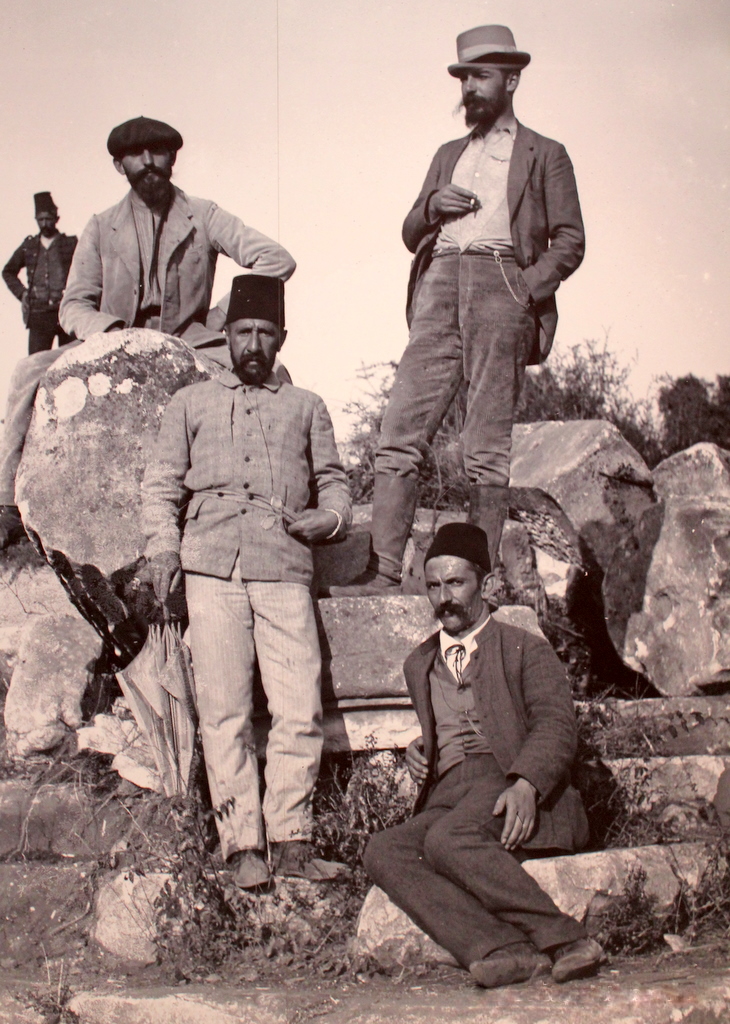
Osman Hamdi Bey, in the middle left, featured with others at an archaeological site in Turkey, 1891-92. |
|
|
| |
|
Osman Hamdi exhibited three paintings at the 1867 Paris Exposition Universelle. None seem to have survived today, but their titles were Repose of the Gypsies, Black Sea Soldier Lying in Wait, and Death of the Soldier. An important step in his career was his assignment as the director of the Imperial Museum (Müze-i Hümayun) in 1881. He used his position as museum director to develop the museum and rewrite the antiquities laws and to create nationally sponsored archaeological expeditions. Osman Hamdi focused on building relationships with international institutions, notably the University of Pennsylvania, from which he received an honorary degree in 1894. In 1902, he painted the excavation of Nippur as a gift to the University of Pennsylvania Museum. In 1882, he instituted and became director of the Academy of Fine Arts, which provided Ottomans with training in aesthetics and artistic techniques without leaving the empire. In 1884, he oversaw the promulgation of a Regulation prohibiting historical artifacts from being smuggled abroad (Asar-ı Atîka Nizamnamesi), a giant step in constituting a legal framework of preservation of the antiquities. Representatives or middlemen of 19th-century European Powers routinely smuggled artifacts with historical value from within the boundaries of the Ottoman Empire (which then comprised the geographies of ancient Greek and Mesopotamian civilizations, among others), often resorting to shadily obtained licenses or bribes, to enrich museums in European capitals.
He conducted the first scientific based archaeological researches done by a Turkish team. His digs included sites as varied as the Commagene tomb-sanctuary in Nemrut Dağı in southeastern Anatolia (a top tourist's venue in Turkey and a UNESCO World Heritage Site today, within the Adıyaman Province), the Hekate sanctuary in Lagina in southwestern Anatolia (much less visited, and within the Muğla Province today), and Sidon in Lebanon. The sarcophagi he discovered in Sidon (including the one known as the Alexander Sarcophagus, although this sarcophagus is thought to contain the remains of either Abdalonymus, King of Sidon; or Mazaeus, a Persian noble who was also the governor of Babylon) are considered among the worldwide jewels of archaeological findings. To lodge these, he started building what is today the Istanbul Archaeology Museum in 1881. The museum officially opened in 1891 under his directorship.
Throughout his professional career as museum and academy director, Osman Hamdi continued to paint in the style of his teachers, Gérôme and Boulanger. Yet, he frequently depicted himself and his family members in these paintings, complicating an assumption of a removed orientalist gaze in his work. |

|
|
|
|
| |
The Tortoise Trainer
|
The Tortoise Trainer
The Tortoise Trainer (W)
Hamdi's 1906 painting, The Tortoise Trainer, holds the record for the most valuable Turkish painting, after being sold for 5 million Turkish Lira (approximately 3.5 million dollars) in December 2004. At the 2004 Artam Antik A.Ç. auction in Istanbul, the Pera Museum and the Turkish Modern Museum fought to acquire the painting, and was ultimately purchased by the Pera Museum. The painting depicts Hamdi's likeness clad in antiquated clothing, training tortoises in a mosque. This choice of subject matter leads many to see this painting as a commentary on Turkey's conflicted national identity. The painting expresses a sarcastic innuendo on the painter's own view of his style of work compared to those of his collaborators and apprentices, and is also a reference to the historical fact of tortoises having been employed for illuminative and decorative purposes, by placing candles on the shell, in evening outings during the Tulip Era in the early 18th century. The painting was acquired by the Suna and İnan Kıraç Foundation and is currently on display at the Pera Museum in İstanbul, which was established by this foundation.
Modern researchers have identified the animals portrayed are Testudo graeca ibera, a variety of the Spur-thighed tortoise. A reproduction of the painting appeared on the cover of the Bibliotheca Herpetologica issue in which the paper about the identification was published.
Historian Edhem Eldem has identified the source of the painting as an engraving of a Korean circus entertainer printed in Le Tour du Monde (1869) which was a popular French travel magazine. The meaning or any symbolic significance of the tortoises is still contested by scholars. |

|
|
|
|
| |
Work
|
Work
Work (W)
Osman Hamdi was a prolific painter and author, whose work dealt with themes of archaeology, travel and folk customs in the Middle East.
Hamdi studied painting in Paris under Gustave Boulanger and Jean-Léon Gérôme, two prominent artists in the French Orientalist school. Despite being trained by Gérôme and Boulanger, and his reproduction of European orientalist motifs, Hamdi's paintings present Ottoman subjects differently than his contemporaries' works, most notably giving them more active and intellectual roles. Hamdi's status as an Ottoman intellectual causes many to see his use of orientalist motifs as subversive and critical of European orientalism. During his lifetime, his artwork was displayed more frequently in Europe than in Turkey.
From 1880 on, he exhibited in Paris, Vienna, Berlin, Munich and London, and started a Salon in Constantinople. His works bear witness to a patient and conscientious method, and may be considered as documents of art history. He was the first who dared break with the Turkish pictorial tradition.
Among his works we may cite : “Prophet’s Tomb at Brussa”, “Miraculous Springs (Paris 1904)”, “Reading the Coran, 1890”, “Theologian” (Patrimony of the Austrian Court).
These paintings can be found in private collections and in museums in Vienna, Paris, Liverpool, New York, Berlin and Constantinople (at the Palace of Dolma Bagdsche, at the home of Crown Prince Abdulmedjid).
His painting of "Reading the Coran, 1890" has been exhibited at “XI BIENNALE INTERNATIONALE DES ANTIQUAIRES” in Paris in 1982 and at the “FINE ART OF THE NETHERLANDS” at the Waldorf-Astoria in New York in November 1982. |

|
|
|
|
Museums
Museums (W)
Berlin “Persian Merchant”, Constantinople “Girl reading” and Liverpool “Young Emir studying”. |
|
|
|
Select list of publications
Select list of publications (W)
- Les Costumes Populaires de la Turquie en 1873, (Popular Costumes in Turkey in 1873) by Osman Hamdi Bey, Marie de Launay and photographs by Pascal Sébah, Turkey, Commission Impériale Ottomane pour l'Exposition Universelle de Vienne, 1873
- Un Ottoman en Orient: Osman Hamdi Bey en Irak, 1869-1871 (An Ottoman in the Orient: Osman Hambdi Bey in Iraq) by Osman Hamdi Bey, Rudolf Lindau, Marie de Launay and Edhem Eldem, c. 1871
- Une Nécropole Royale à Sidon: Fouilles de Hamdy Bey, (A Royal Necropolis in Sidon: Excavations by Hamdy Bey) by Osman Hamdi Bey, Paris, E. Leroux, 1892
- Le voyage à Nemrud Dağı d'Osman Hamdi Bey et Osgan Efendi (1883): récit de voyage et photographies, (The trip to Nemrud Dağı by Osman Hamdi Bey and Osgan Efendi (1883): travelogue and photographs) by Osman Hamdi Bey, Paris, 1883
- Le Tumulus de Nemrut-Dagi, (The Nemrut-Dagi Mound), by Osman Hamdi Bey, Constantinople, F. Lœffler, 1883
|
|
|
|
|
🎨 Paintings at the Pera Museum, Istanbul
Paintings at the Pera Museum, Istanbul (W)
|
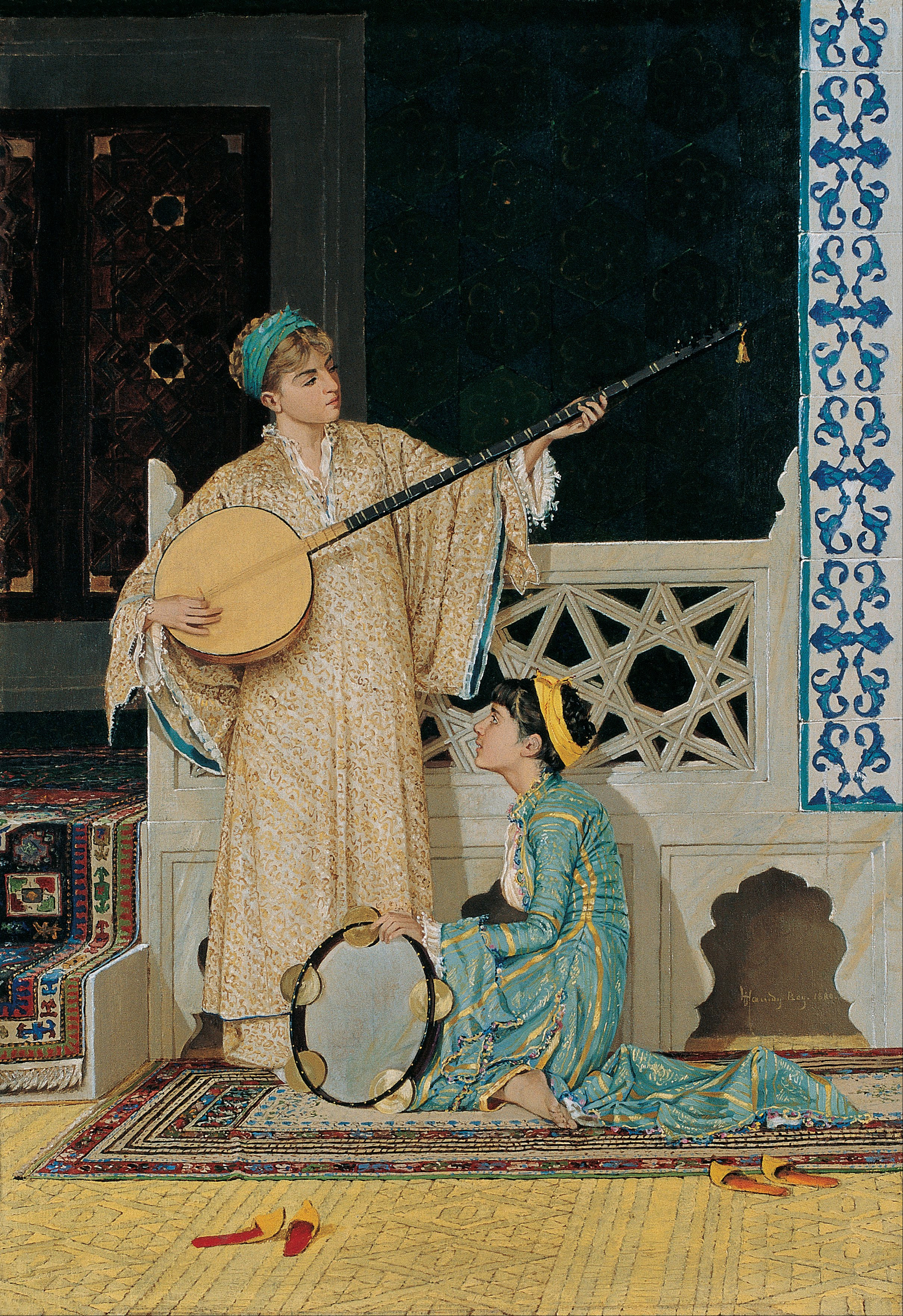
“Two Musician Girls.” |
|
|
|
|
| |
|
|
|
🎨 Paintings at museums outside Turkey
Paintings at museums outside Turkey (W)
|
|
| |
|
|
|
|
| |
Family
|
Family
Family (W)
- His daughter Nazlı Hamdi (1893-1958) married an Ottoman diplomat, Esat Cemil Bey, in 1912, and the couple had one daughter, Cenan Hamdi Sarç, who lived 99 years and died in 2012. Cenan Hamdi married Ömer Celal Sarç, who was the rector of Istanbul University in 1932. She had one son, Faruk Sarç, who was born in 1933. In 1932, Nazlı Hamdi married French engineer, Audoin Fouache d’Halloy (1889-1948).
- He was the brother of Halil Edhem Eldem, who became the Director of the Istanbul Archaeology Museums after his death, and served as a Member of Parliament at the Grand National Assembly of Turkey for ten years under the newly founded Turkish Republic.
- He was the brother of İsmail Galib Bey, considered the founder of numismatics as a scientific discipline in Turkey.
- He was the granduncle of Sedad Hakkı Eldem, a renowned Turkish architect.
- He was the granduncle of Cemal Reşit Rey, one of the five pioneers of classical music in Turkey (termed the Turkish Five.)
|
|
|
|

|
|
|
|
|
|
|
|
